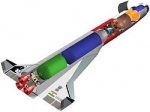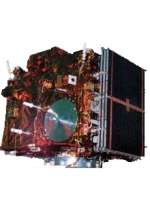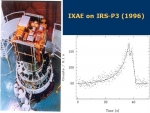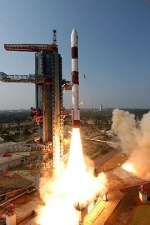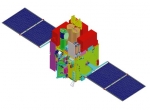Displaying items by tag: India
Avatar (spaceplane)
AVATAR (from "Aerobic Vehicle for Hypersonic Aerospace TrAnspoRtation") was a concept development effort for a single-stage reusable spaceplane capable of horizontal takeoff and landing, by India's Defense Research and Development Organization along with Indian Space Research Organization and other research institutions.
The mission concept was for cheaper military and civilian satellite space launches. The idea was to develop a hyperplane vehicle that can take off from conventional airfields, collect air in the atmosphere on the way up, liquefy it, separate oxygen and store it on board for subsequent flight beyond the atmosphere. The AVATAR RLV was first announced in May 1998 at the Aero India 98 exhibition held at Bangalore. It was planned to be the size of a MiG-25 fighter and would be capable of delivering a 500 kg to 1,000 kg payload to low earth orbit at very low cost for an estimated vehicle life of 100 launches.
IRS-P3
IRS-P3 is an Indian experimental Earth Observation mission, considered to be pre-operational and serving in parallel for technology evaluation and scientific methodology studies.
It was launched by PSLV-D3 on March 21, 1996 from SHAR Centre, Sriharikota, India. IRS-P3 carries two remote sensing payloads - Wide Field Sensor (WiFS) similar to that of IRS-1C, with an additional Short Wave Infrared Band (SWIR) and a Modular Opto-electronic Scanner (MOS). It also carries an X-ray astronomy payload and a C-band transponder for radar calibration.
Mission completed during January 2006 after serving 9 years and 10 months.
IXAE
The X-ray Astronomy Experiment (IXAE) is a payload which was launched aboard the Indian Remote Sensing Satellite-P3 (IRS-P3) using a Polar Satellite Launch Vehicle (PSLV) on 1996 March 21.
(see article IXAE observations of the X-ray pulsar XTE J1946+274 )
Polar Satellite Launch Vehicle (PSLV)
The Polar Satellite Launch Vehicle, commonly known by its abbreviation PSLV, is an expendable launch system developed and operated by the Indian Space Research Organisation (ISRO). It was developed to allow India to launch its Indian Remote Sensing (IRS) satellites into Sun synchronous orbits, a service that was, until the advent of the PSLV, commercially viable only from Russia. PSLV can also launch small size satellites into geostationary transfer orbit (GTO). The PSLV has launched 52 satellites (26 Indian satellites and 26 foreign satellites) into a variety of orbits to date (May 2012).
Astrosat
Astrosat is India's first dedicated astronomy satellite and is scheduled to launch on board the PSLV in 2012. After the success of the satellite-borne Indian X-ray Astronomy Experiment (IXAE), which was launched in 1996, the Indian Space Research Organization (ISRO) has approved further development for a full fledged astronomy satellite - Astrosat.
A large number of leading astronomy research institutions in India and abroad are jointly building various instruments for the satellite. Important areas requiring broad band coverage include studies of astrophysical objects ranging from the nearby solar system objects to distant stars, to objects at cosmological distances; timing studies of variables ranging from pulsations of the hot white dwarfs to active galactic nuclei (AGN) with time scales ranging from milliseconds to few hours to days.
Astrosat is currently proposed as a multi-wavelength astronomy mission on an IRS-class satellite into a near-Earth, equatorial orbit by the PSLV. The 5 instruments on-board cover the visible (320-530 nm), near UV(180-300 nm), far UV(130-180 nm), soft X-ray (0.3-8 keV and 2-10 keV) and hard X-ray (3-80 keV and 10-150 keV) regions of the electromagnetic spectrum.
Mission
Astrosat will be a proposal-driven general purpose observatory, with main scientific focus on:
- Simultaneous multi-wavelength monitoring of intensity variations in a broad range of cosmic sources
- Monitoring the X-ray sky for new transients
- Sky surveys in the hard X-ray and UV bands
- Broadband spectroscopic studies of X-ray binaries, AGN, SNRs, clusters of galaxies and stellar coronae
- Studies of periodic and non-periodic variability of X-ray sources

